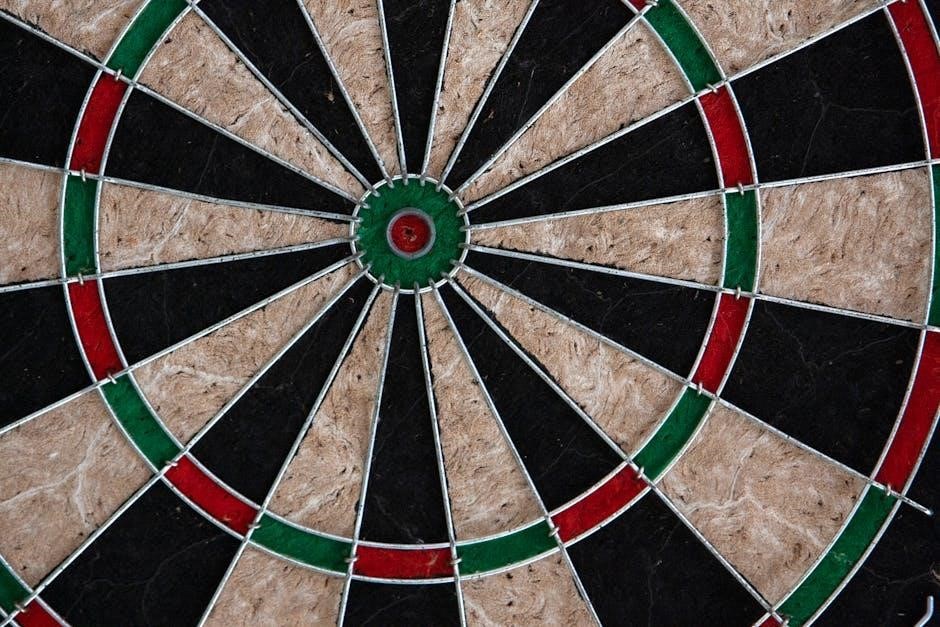Welcome to the 3 Hole Punch Centering Guide! This guide helps you achieve precise hole alignment for professional results. Learn proper techniques, standard measurements, and practical tips to ensure perfectly centered holes every time.
1.1 Importance of Proper Hole Alignment
Proper hole alignment is essential for ensuring functionality and professionalism in bound documents. Misaligned holes can lead to pages not fitting properly in binders, causing inconvenience and unprofessional presentation. Standard measurements, such as the 4.25-inch spacing between hole centers and 0.5-inch distance from the edge, are critical for compatibility with common binding systems. Accurate alignment also enhances durability, as evenly distributed holes reduce the risk of tearing. Additionally, proper centering contributes to a polished appearance, making it vital for both personal and professional use. By following precise guidelines, you can achieve consistent results and maintain the integrity of your documents. Proper alignment is the foundation of effective 3-hole punching.
1.2 Brief Overview of 3 Hole Punching
3-hole punching is a common binding method used to create professional-looking documents. It involves punching three evenly spaced holes along the binding edge of paper, typically at standard measurements of 4.25 inches between hole centers and 0.5 inches from the edge. This setup ensures compatibility with standard 3-ring binders. The process is straightforward: align the paper with the punch tool, ensuring proper centering, and apply pressure to create clean holes. Adjustable punches allow for customization, while fixed models offer simplicity. Proper technique and alignment are crucial for consistent results. This method is widely used in offices, schools, and homes for organizing and presenting documents neatly. Understanding the basics of 3-hole punching is the first step toward achieving perfectly centered holes every time.
Understanding Standard 3 Hole Punch Measurements
Standard 3-hole punch measurements ensure compatibility with binders. The center-to-center distance between holes is typically 4.25 inches, with the first hole 0.5 inches from the paper’s edge.
2.1 Standard Hole Spacing and Dimensions
Standard 3-hole punch spacing typically features centers 4.25 inches apart, ensuring compatibility with most binders. The first hole is usually 0.5 inches from the paper’s edge. This measurement ensures uniformity across documents, making it easier to organize and bind papers securely. The standard dimensions are designed to align with common binding systems, providing a professional finish. However, some adjustable punches allow for variations in spacing, accommodating different paper sizes or specific requirements. Proper alignment is crucial to maintain consistency and avoid misaligned holes. Always verify the measurements before punching to ensure accuracy and compatibility with your binding system.

2.2 Distance from Edge to First Hole Center
The distance from the edge of the paper to the center of the first hole is typically 0.5 inches, ensuring consistent alignment. This standard measurement is crucial for maintaining uniformity across documents and compatibility with most binding systems. Proper alignment prevents misaligned holes and ensures pages lie flat when bound. For accuracy, use guides or templates to mark the center point before punching. Adjustments may be needed for different paper sizes or specific requirements. Always double-check measurements to avoid errors, as precise alignment is key to achieving professional results. This step ensures your documents are neatly organized and securely fastened, making the punching process efficient and reliable.
2.3 Common Mistakes in Measurement
One of the most common mistakes in 3 hole punching is incorrect spacing between holes. The standard spacing is typically 4.25 inches between hole centers, but misalignment can occur if measurements are not precise. Another error is uneven distance from the edge to the first hole, which should be 0.5 inches. Neglecting to use guides or templates often leads to misaligned holes. Additionally, failing to double-check measurements before punching can result in inconsistent spacing. To avoid these issues, always use a ruler or alignment tool to mark the center points accurately. Proper measurement ensures professional results and compatibility with standard binding systems. Avoid rushing the process, as small errors can lead to poorly aligned holes and wasted materials.
Choosing the Right 3 Hole Punch Tool
Selecting the right 3 hole punch ensures accuracy and efficiency. Look for tools with adjustable spacing and alignment guides to achieve precise centering. Durable construction and sharp blades are essential for clean punches and long-term use. Consider ergonomic designs for comfort during extended use. Adjustable models offer flexibility for different projects, while fixed punches provide consistency for standard tasks. A good tool will help you achieve professional results and maintain productivity. Always check for features that enhance alignment and ease of use to ensure your punching needs are met effectively.
3.1 Features to Look for in a 3 Hole Punch
When selecting a 3 hole punch, prioritize features that enhance accuracy and ease of use. Look for adjustable spacing to customize hole alignment according to your needs. A built-in alignment guide or template ensures consistent centering. Sharp, high-quality blades are essential for clean punches and prevent tearing. Ergonomic handles reduce fatigue during extended use. Consider a punch with a paper guide to help position documents correctly. Some models offer adjustable depth settings, allowing you to control the distance from the edge to the first hole. Durable construction ensures longevity, while a removable chip tray makes cleanup effortless. Additional features like a locking mechanism can secure the punch in place, preventing movement during use. These features collectively help achieve precise, professional results for your 3 hole punching tasks.
3.2 Adjustable vs. Fixed Hole Punches

Choosing between adjustable and fixed 3 hole punches depends on your specific needs. Adjustable punches offer flexibility, allowing you to customize hole spacing and alignment. This feature is ideal for projects requiring non-standard measurements or frequent adjustments. On the other hand, fixed hole punches are designed for consistency, with predetermined spacing that ensures uniform results. They are often more durable and require less maintenance. Adjustable punches may be more versatile but can be bulkier and require more setup. Fixed punches are simpler to use and suit standard 3-hole punching tasks. Consider your workflow and desired outcomes to decide which type best fits your requirements for precise and efficient hole centering.

Step-by-Step Guide to Centering Holes
- Measure and mark the center points on the paper accurately.
- Align the paper with the punch, ensuring proper positioning.
- Punch the holes with steady pressure for clean results.
- Verify the centering by checking hole alignment and spacing.
4.1 Measuring and Marking the Paper
Accurate measurement is crucial for centering holes. Start by measuring the distance from the edge of the paper to the center of the first hole, typically 0.5 inches. Use a ruler or measuring tool to mark this point clearly. Next, measure the spacing between the holes, ensuring the centers are 4.25 inches apart for standard three-hole punching. Lightly mark these points with a pencil to guide alignment. For consistency, consider using a template or guide to help visualize the hole placement. Double-check your measurements to avoid errors. Proper marking ensures precise alignment when using the punch tool, leading to professional-looking results. This step sets the foundation for achieving perfectly centered holes every time.
4.2 Aligning the Paper with the Punch
Once the paper is measured and marked, align it with the 3-hole punch. Place the paper on a flat surface and position it under the punch tool. Use the guides or markings on the punch to ensure the paper is centered. Align the edge of the paper with the punch’s edge guide to maintain consistency. If your punch has adjustable guides, set them to match the width of your paper. Gently slide the paper left or right to center it under the punch holes. Double-check that the marks you made align with the centers of the punch holes. This step ensures that the holes will be punched in the correct position. Proper alignment is key to achieving professional-looking results. Take your time to ensure accuracy before proceeding to punch the holes.
4.3 Punching the Holes Accurately
With the paper properly aligned, gently squeeze the punch handle to create the holes. Ensure the paper is secure and flat to avoid shifting during punching. Apply even pressure to the handle to ensure clean, precise holes. If using an adjustable punch, double-check that the settings match your paper size. For thicker paper stacks, punch a few sheets at a time to prevent jamming. After punching, inspect the holes to ensure they are evenly spaced and centered. If necessary, adjust the alignment and repeat the process. Accurate punching is crucial for professional results, so take care to maintain consistency and precision throughout the process.

4.4 Verifying the Centering
After punching, inspect the holes to ensure they are evenly spaced and centered. Measure the distance between the holes and from the edge to confirm accuracy. Use a ruler to check alignment with standard measurements, such as 4.25 inches between hole centers and 0.5 inches from the edge. Compare the punched holes to your original markings to verify precision. If misalignment is detected, adjust the paper position and re-punch. Consistency is key, so ensure all sheets in a batch are punched identically. For added accuracy, use a template or guide to cross-reference your results. Proper verification ensures professional-quality outcomes and prevents issues during binding or further processing.

Tips for Achieving Perfect Centering
Use guides and templates for accuracy. Align paper carefully before punching. Double-check measurements to avoid errors. Maintain your punch tool for consistent results.
5.1 Using Guides and Templates
Using guides and templates is essential for achieving precise centering when punching holes. These tools help ensure consistent alignment and spacing, especially for standard measurements like 4.25 inches between hole centers and 0.5 inches from the edge. Guides can be built into the punch or separate, while templates provide pre-marked layouts for various paper sizes. By aligning your paper with these aids, you minimize errors and save time. For example, integrated paper guides on punches help center the page, while printable templates offer a visual reference. Always double-check your alignment before punching to ensure accuracy. This method is particularly useful for bulk punching or when consistency across multiple documents is crucial.
5.2 Ensuring Paper Alignment
Proper paper alignment is critical for achieving centered holes. Start by positioning the paper evenly under the punch, using built-in guides or markers to center it. Ensure the paper’s edge aligns with the punch’s edge guide, and the center mark on the punch matches the paper’s midpoint. For consistent results, use a ruler or template to mark the center point before punching. Double-check the alignment by visually inspecting the paper’s position relative to the punch holes. Misalignment can lead to uneven holes, so take your time to adjust the paper as needed. This step is especially important for bulk punching or when working with sensitive documents. Proper alignment ensures professional-looking results every time.
5.3 Avoiding Common Errors

To ensure accurate centering, avoid common mistakes such as misaligning the paper or miscalculating measurements. Always double-check the distance from the edge to the first hole center, typically 0.5 inches, and ensure the spacing between holes is consistent. Use guides or templates to prevent misalignment and verify the punch’s adjustment before use. Rushing the process can lead to uneven holes, so take your time. Additionally, avoid stacking too many papers, as this can cause shifting during punching. Regularly cleaning and maintaining the punch tool will also help prevent errors. By being meticulous and following these tips, you can achieve perfectly centered holes every time and avoid costly rework.
Maintenance and Care of the 3 Hole Punch
Regularly clean the punch to remove debris and sharpen blades for optimal performance. Use guides to align paper accurately and avoid misalignment issues. Proper care ensures longevity and precision.
6.1 Cleaning the Punch
Cleaning the 3 hole punch is essential for maintaining its performance and ensuring precise hole centering. Use a soft, dry cloth to wipe away dust, paper debris, and residue from the punch heads and surfaces. Avoid using harsh chemicals or abrasive materials, as they may damage the metal components. For stubborn residue, lightly dampen the cloth with water, but ensure the punch is thoroughly dry afterward to prevent rust. Regular cleaning prevents paper jams and misalignment issues. Additionally, inspect the punch blades for dullness or debris buildup, as this can affect the accuracy of your punches. By keeping the tool clean and well-maintained, you ensure consistent results and extend its lifespan.
6.2 Sharpening the Punch Blades
Sharpening the punch blades is crucial for maintaining their effectiveness and ensuring clean, precise holes. Over time, blades can become dull, leading to torn paper and misaligned holes. To sharpen, use a sharpening stone or diamond stone, focusing on the cutting edge at a 20-30 degree angle. Lightly draw the blade across the stone in one direction, repeating until the edge is sharp. Avoid using power tools, as they may overheat and damage the metal. After sharpening, clean the blades to remove any metal shavings. Regular sharpening prevents jams and ensures accurate centering. For optimal performance, sharpen the blades whenever you notice a decline in punch quality or an increase in paper tearing.
Troubleshooting Common Issues
Identify and resolve issues like misaligned holes or jammed paper by adjusting alignment, clearing debris, or sharpening dull blades to ensure smooth punching and accurate centering.
7.1 Misaligned Holes
Misaligned holes are a common issue when using a 3 hole punch. This problem often arises from incorrect measurement of the paper’s edge or improper alignment with the punch guide. To fix this, ensure the paper is centered and the punch is calibrated correctly. If holes are consistently off, check the spacing between the punch heads and adjust them if necessary. Using a ruler or template can help verify the distance from the edge to the first hole center, which should typically be 0.5 inches. Regular maintenance, such as cleaning and sharpening the blades, can also prevent misalignment. Always double-check your setup before punching to avoid wasted paper and ensure professional results.
7.2 Jammed Paper
Jammed paper in a 3 hole punch can be frustrating and disrupt your workflow. This issue often occurs when paper is not properly aligned or too many sheets are punched at once. To resolve this, carefully turn the punch over and gently remove the jammed paper. Avoid using force, as it may damage the tool. If the paper is stubborn, use a small tool like a screwdriver to pry it loose. To prevent jams, ensure the paper is aligned correctly and the punch blades are sharp. Dull blades can cause tearing and increase the likelihood of jams. Regular maintenance, such as cleaning and sharpening the blades, will also help maintain smooth operation and reduce the risk of paper getting stuck.

Advanced Techniques for Centering
For precise results, use laser guides or specialized alignment tools. These advanced methods ensure accurate hole centering, especially for professional or high-volume projects requiring utmost precision and consistency.
8.1 Using Laser Guides

Laser guides are advanced tools that project precise alignment markers, ensuring accurate hole centering. These guides emit a visible beam, helping you position the paper correctly before punching. By aligning the paper’s edge or center with the laser line, you achieve consistent results. Many modern 3-hole punches come with built-in laser guides, while others can be paired with external devices. To use a laser guide effectively, place the paper on the punch base, adjust the laser to align with your desired hole positions, and ensure the beam matches your project’s requirements. This method is ideal for professional or high-volume tasks, as it minimizes errors and saves time. Regularly check and calibrate the laser for optimal accuracy.

8.2 Double-Check Alignment
Double-checking alignment is crucial for achieving perfectly centered holes. Before punching, ensure the paper is properly aligned with the guide or template. Visually inspect the positioning to confirm accuracy. Use a ruler or measuring tool to verify the distance from the edge to the first hole center, ensuring it matches the standard measurement of 0.5 inches. For added precision, mark the center point with a pencil before aligning the paper with the punch. This step helps prevent misaligned holes and ensures consistency, especially when working with multiple sheets. By double-checking, you can avoid costly mistakes and achieve professional-looking results every time. This method is particularly useful for users who are still mastering the technique or working on critical projects.
Conclusion
In conclusion, mastering the 3 hole punch centering guide ensures precise and professional results. By following the steps outlined, from measuring and aligning to punching and verifying, you can achieve perfectly centered holes every time. Remember to use guides, templates, and proper tools to maintain accuracy. Regular maintenance of your punch, such as cleaning and sharpening, will extend its lifespan and performance. Troubleshooting common issues like misaligned holes or jammed paper can save time and frustration. With practice and attention to detail, you’ll become proficient in centering holes, whether for personal projects or professional tasks. This guide provides a comprehensive approach to achieving flawless results, helping you work efficiently and effectively.
